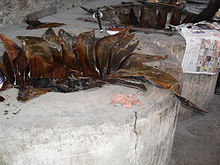Barbacoa

Barbacoa (Spanish: [baɾβaˈkoa] ⓘ) in Mexico, refers to the local indigenous variation of the primitive method of cooking in a pit or earth oven.[1] It generally refers to slow-cooking meats or whole sheep, whole cows, whole beef heads, or whole goats in a hole dug in the ground covered with agave (maguey) leaves, although the interpretation is loose, and in the present day (and in some cases) may refer to meat steamed until tender. This meat is known for its high fat content and strong flavor, often accompanied with onions and cilantro (coriander leaf).
Being that it’s not unique to Mexico, similar methods exist throughout Latin America and the rest of the world,[2] under distinct names, including: pachamanca and huatia in the Andean region; curanto in Chile and southern Argentina; berarubu[3][4] in Brazil; cocido enterrado[5] in Colombia; or hāngī in New Zealand.
Although it’s speculated that the word ”barbacoa” may have originated from the Taíno language, this method of cooking in an earth oven has nothing to do with the original Taíno definition of the word.[6]
Adaptations[edit]

In the U.S., barbacoa is often prepared with parts from the heads of cattle, such as the cheeks. In northern Mexico, it is also sometimes made from beef head, but more often it is prepared from goat meat (cabrito). In central Mexico, the meat of choice is lamb, and in the Yucatan, their traditional version, cochinita pibil (pit-style pork), is prepared with pork.
Barbacoa was later adopted into the cuisine of the southwestern United States by way of Texas. The word transformed in time to "barbecue".[7]
In the Philippines, the Visayan dish balbacua (also spelled balbakwa) is named after barbacoa, probably for the similar length of cooking time and tenderness of the meat. It is a completely different dish. Unlike Latin American versions, it is a stew made from beef, oxtail, cow feet and skin boiled for several hours until gelatinous and extremely tender.[8][9]
Etymology[edit]

The word barbacoa is believed to have come from the mainland Taino (eastern Dominican Republic), as in this source:
But let's take the word barbacoa, whose origin arau[a]co (specifically, Taíno) is known thanks to the descriptions of Gonzalo Fernández de Oviedo in his Historia natural y general de las Indias, who testifies to two of his meanings.[10]
But when we take the term 'barbacoa', which originates from Arawak (specifically, the Taíno language), it is known thanks to the writings of Gonzalo Fernández de Oviedo in his Natural and General History of the Indians, who described two of its meanings: «some sticks that they put, like a grill or trivets, in a hole, to roast the fish and animals they hunted. Such an assertion competes with the thesis that, when designating a type of barbecue, that word is a Castilianization of the English-North American word barbecue, which in turn is born from the French expression la barbe á la queue ("of the beard 3⁄4 o mentón 3⁄4 to the tail", which was how French-speaking Canadian trappers skewered the cattle they hunted with an iron bar to roast them.
This article needs translation into English. This article is written in a language other than English. If it is intended for readers from the community of that language, it should be contributed to the Wikipedia in that language. See the list of Wikipedias. Please see this article's entry on Pages needing translation into English for discussion. If the article is not rewritten in English within the next two weeks it will be listed for deletion and/or moved to the Wikipedia in its current language. If you have just labeled this article as needing translation, please add {{subst:uw-notenglish|1=Barbacoa}} ~~~~on the talk page of the author. |
Notable restaurants[edit]
Brownsville Texas's Vera's Backyard Bar-B-Que as of 2022 is the only restaurant in Texas still serving barbacoa made using the traditional method commercially because they are grandfathered in; all other legal commercial providers steam the meat rather than pit-smoking it.[11][12][13]
See also[edit]
References[edit]
- ^ Espinosa, Isidro Félix de (1746). Chronica Apostólica y Seraphica de todos los Colegios de Propaganda Fide de esta Nueva-España de Missioneros Franciscanos Observantes. Mexico: Viuda de D. Joseph Bernardo de Hogal. p. 470. Retrieved 5 May 2024.
- ^ Miglio, Paola. "Así se cuecen los alimentos bajo tierra en Latinoamérica". Revista Diners. Retrieved 5 May 2024.
- ^ "Berarubu". Etnolinguistica. Biblioteca Digital Curt Nimuendaju. Retrieved 5 May 2024.
- ^ "'Festa do Berarubu' relembra tradição da culinária indígena no Tocantins". G1. Globo. Retrieved 5 May 2024.
- ^ "COCIDO ENTERRADO". El Toque Colombiano. Retrieved 5 May 2024.
- ^ Pineda, Pedro (1740). New Dictionary, Spanish and English and English and Spanish. London: F. Gyles. Retrieved 5 May 2024.
- ^ "Barbecue | Define Barbecue at Dictionary.com". Dictionary.reference.com. Archived from the original on 8 April 2010. Retrieved 4 April 2010.
- ^ "Balbacua". Panlasang Pinoy. Retrieved 2 August 2015.
- ^ "Lanciao & Balbacua". Market Manila. Retrieved 2 August 2015.
- ^ "IV CILE. Paneles y ponencias. Eusebio Leal Spengler". Congresosdelalengua.es. Archived from the original on 11 April 2010. Retrieved 4 April 2010.
- ^ Vaughn, Daniel (26 March 2012). "Vera's Backyard Bar-B-Que". Texas Monthly.
- ^ Ralat, Jose R. (21 April 2014). "Vera's Backyard Bar-B-Que". Cowboys and Indians Magazine. Retrieved 1 March 2023.
- ^ "A Visit to Vera's, the Last Bastion of Barbacoa de Cabeza". Texas Monthly. 20 July 2022. Retrieved 1 March 2023.













